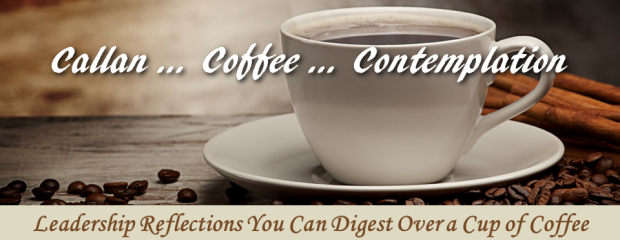Callan…Coffee…Contemplation for the Week of June 9th
Born or Made?
Today I am contemplating this question: “Are great leaders born or made?” Though I believe people are born with different inherent attributes, that is just a starting point. In the final analysis, I believe great leaders, like true heroes, are made. Why? Because great leaders are, foremost, great human beings, and they became great people through an arduous and life-long process of self-mastery. Whatever greatness ultimately comes forth from them, it does so from the inside, out. Like a diamond born of coal, the latent greatness must be slowly revealed through the pressure of time, experience, failure, and the constant crossing of growth thresholds. Great leaders are made in the cauldron of life and via the crucible of experience. Those who transform and convert via this crucible become significant; those who whither in this crucible are forgotten. Great leaders must pass through various initiations and rites of passage throughout their lives. Without some defeats and wounds, and necessary conversion, we become prisoner to our ego. Great leaders master themselves. So yes, great leaders are made, not born!
Know Your Lens
When I reflect on great leaders, truly significant people with enduring impact, I see clearly how each one came to possess self mastery in their life. Mastering oneself involves refining and improving one’s paradigm—or lens—which dictates how we see and hear. This is why I try to remind myself—“know your lens.” If we are not self aware, we can become victim to a negative paradigm and thus trapped in a corrosive view of living and leading. Whatever our lens is at the present moment is exactly how we will see and hear everything in which we engage. Our lens determines our biases, our pre-conditions, our agendas, and our preferences. For most of us, if we are not aware of our filters, our lens can be mostly focused on ourselves. This is why some leaders get older in chronological years but never lose their ego-centered lens. This is why it never stops being about themselves. Great leaders, however, learn to become aware of their filters, transform themselves, and consistently clean their lens. People who do not know their filters struggle to become wise leaders.
The Labyrinth
I incorporated the image of a labyrinth into my leadership logo because the mythic maze reminded me of the true nature of leadership. First, leadership is hard and effortful; we all must start in the center of the labyrinth and, through tests and trials, endeavor to make our way through towards excellence. Second, there are no shortcuts or gimmicks in leadership. Much like the hero Theseus trapped in the Cretan labyrinth, the best we can gain are subtle clues. It is up to us to listen for those clues, gain mastery by solving the mysteries of leadership ourselves, and courageously walk the twisting pathways. Third, the labyrinth reminds me that true progress as a leader is never a straight or smooth path. We will not progress as leaders in the shortest route possible. Leadership is a formidable journey of one step forward and two steps back, where paradoxically, the two steps back are often the most important and usually the most instructive. The labyrinth keeps us focused and centered on the leadership path. Fidelity to this labyrinthine path is, in the end, the most crucial ingredient to significance.
Gung Ho
Gung Ho is an Anglicized version of a Chinese phrase picked up by US Marines during duty in China in the early 1900s. Gung Ho conveyed a certain spirit of enthusiasm, and as such, was used to suggest an enthusiasm of working together in physical, mental, spiritual, and psychological harmony. Over time, Gung Ho became a common hallmark phrase in every generation of Marines. I’ve always loved the idea of Gung Ho, as I think it correctly captures the positive impact of individuals willingly choosing to be wholehearted in their efforts. Gung Ho is a necessary reminder to be mindful, fully engaged, and fully enthusiastic in things that matter. The spirit of Gung Ho also reveals one of life’s truest maxims: Anything we do wholeheartedly, in which we give our full measure, brings us the greatest joy and deepest satisfaction. I truly believe people do not get burned out from too much hard work as much as they mentally fatigue, and often quit, when they are involved in half-hearted or mindless pursuits. Purpose and meaning, pursued vigorously, do not tire us, they enliven us. Gung Ho!
Falling and Rising … Loss and Renewal
When we honestly reflect on the life of past great leaders, and comprehend the full arc of their lives, a pattern of falling and rising emerges, not just once, but repeatedly. Can you name one truly great leader, someone of profound significance and enduring excellence, who does not follow this cycle of defeat and re-birth? I can’t. It seems the falling and rising are both necessary to transformation and conversion of great leaders; the falling taught the lessons of the descent; the rising taught the lessons of the ascent. This cycle is the necessary crucible to hammer forth stronger and sturdier character. More importantly, the fall was as important, if not more, than the rise, for as we observe so often, the falling is most often the handmaiden of the birth of our better self and our more heroic leadership. This truth is particularly important because as leaders we don’t like to think of falling or failing. Winning is sexier. But understood correctly, any initial loss, dealt with courageously and with candor, is the very thing leading us to renewal and a higher plane of leadership and wisdom.
Check back next Monday for a round up of this week’s social media shares. Or check us out on Facebook,Twitter, Google+, or Pinterest to see our posts every day!
Tweet Share






